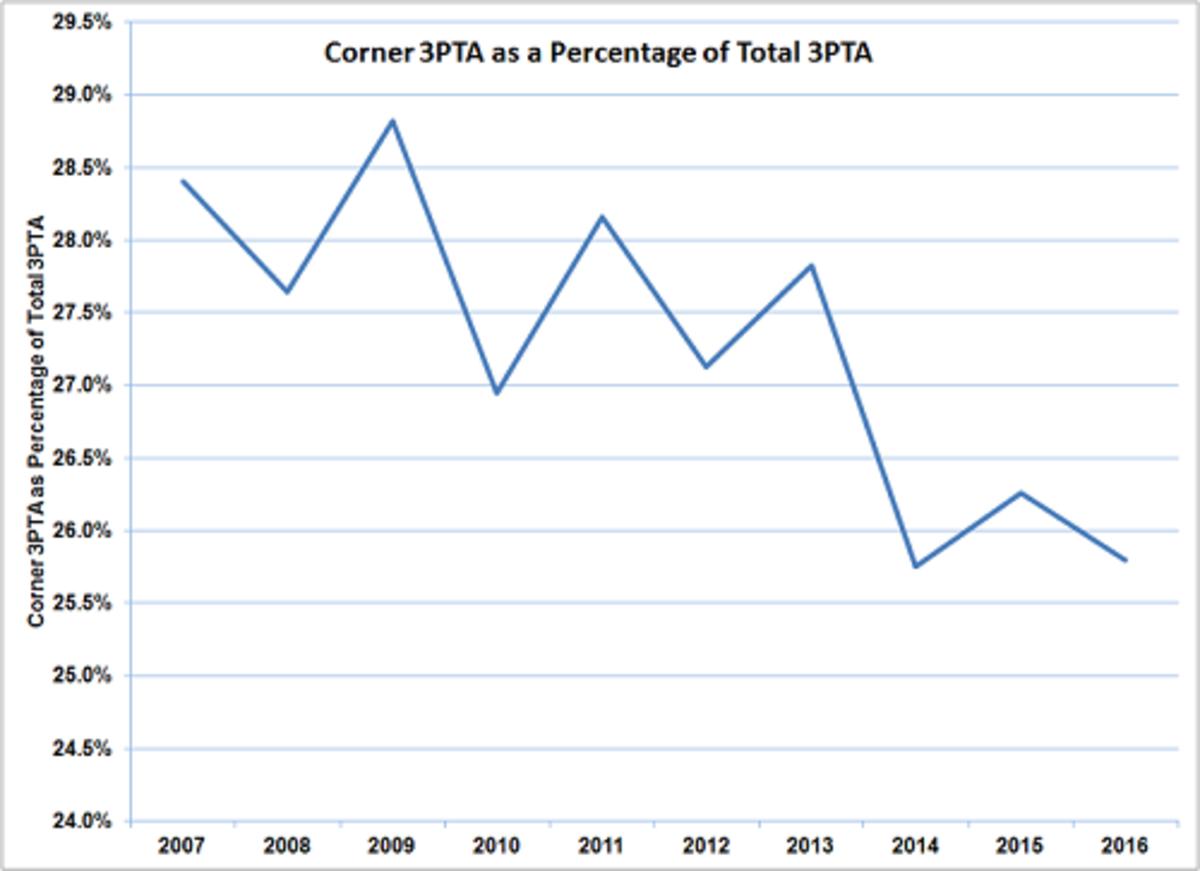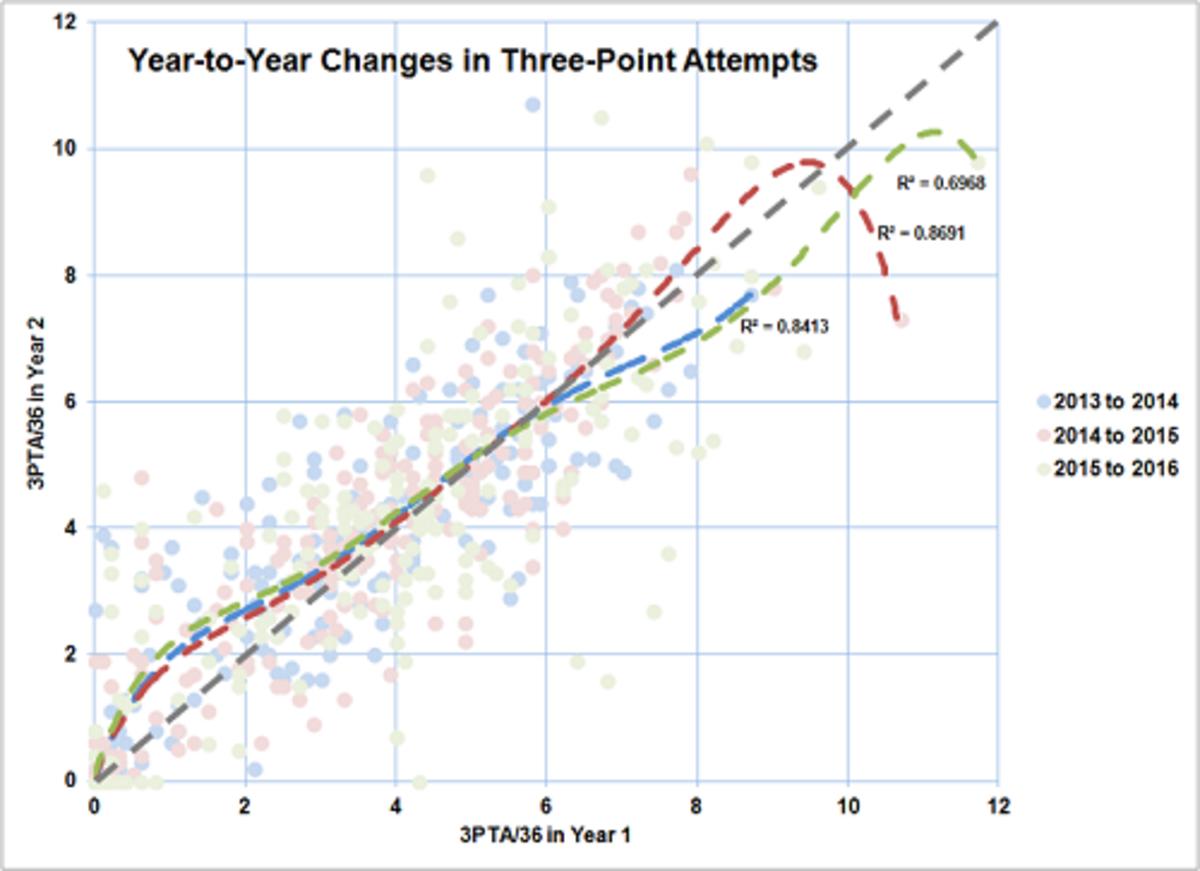The changing math behind the increased taking of NBA 3-pointers

As advertised, through the first week of the NBA season, everything has been about the 3-pointer.
Last season, teams averaged 22.4 3-point attempts per game, which was a league record. So far this season, 20 teams are above that mark, and the league average has risen to 23.7 a game. The Los Angeles Lakers and Charlotte Hornets are both taking nearly 10 more threes per game than they did last year, and even the Memphis Grizzlies, who attempted 860 fewer three-pointers than anyone else in the league over the last three seasons, have upped their per-game average by about four attempts.
Perhaps it just took the begrudging admission of Charles Barkley that jumpshooting teams have won more championships than him, but every team in the league appears to be figuring out how it can get more of its shot attempts from behind the arc.
While attempts have increased, though, accuracy has lagged behind; through the first week, the league had made just 33.0 percent of its 3-point attempts. That’s down from 35.0 percent last season (and 36.0 percent in 2013–14), and would be the lowest league average since 1991–92. While it seems unlikely that the league as a whole will continue to shoot this poorly, the combination of increased attempts and decreasing accuracy has been a general trend for awhile. Relative to the expected value of 2-pointers, threes were worth less last season than at any other point in the last decade.
This sort of diminishing return on 3-pointers has been looming for awhile. As more and more teams are hunting for them offensively, the job of a defense, theoretically, becomes easier (at least from a planning standpoint). An offense can only create so many high-quality 3-point looks. If the goal is simply to keep taking more threes, that means taking some that are less optimal.
Attempts from the corners have long been the crown jewel of 3-pointers; over the past decade, they have usually been made at rates four to five percentage points higher than above-the-break threes. Generally, this advantage is more about additional space between the shooter and the defender than the shot being closer distance to the basket. However, they have gradually been making up a smaller and smaller share of all three-point attempts.

Even if every team was continuing to make three-point shots at a steady percentage, simply shifting threes from the corners to above the break would decrease the league’s three-point percentage. The decrease here is still fairly small, though, and probably only worth tenths of a percentage point in terms of the overall league average. And if we compare 3-pointers by two other characteristics that we know have a significant effect on value — defender distance and whether they’re off the dribble or catch-and-shoot — we see they are not obvious culprits, either.
Teams are taking slightly more pull-up threes, with the percentage coming from that category rising from 23.6 percent in 2013–14 to 25.2 percent thus far this season (per NBA.com), but — like the decline in the percentage of corner 3-pointers — it is a narrow change. Between that and the average defender distance remaining nearly the same, it’s hard to argue that the decline in three-point accuracy is due to teams forcing shots in less-than-ideal contexts.
However, the data we’ve looked at so far only focuses on the shots themselves. As teams reshape their offenses around three-pointers, more and more players are looking to expand their range. For example, Al Horford had 68 career 3-point attempts coming into this season, and he’s already taken 18 in five games. Ditto for DeMarcus Cousins, who has attempted 10 in three games after only attempting 69 threes across his first 350 career NBA games. In fact, a great deal of the increase in 3-pointers over the past few seasons has come from non-shooters expanding their range.
The graph below looks at the year-to-year changes in 3-point attempts per 36 minutes for each individual player over the past four seasons.

This data set only includes players who played at least 40 games and averaged at least 10 minutes per game in both seasons (or just 10 minutes per game in the case of this season). If every player’s 3-point rate stayed exactly the same, they would fall right along the dark grey line. Obviously, players change their rates from season to season, which is why the dots are scattered both above and below the line.
The colored trend lines are an approximation of the patterns in change. What’s really important is the bubble toward the bottom left-hand corner. Each of the past three seasons have followed roughly the same pattern — players who were not 3-point shooters are the ones seeing the biggest increase in 3-point attempts, year-to-year.
For example, of the 20 players who have increased their 3-point attempts per 36 minutes by the biggest margin this season, 11 are players who averaged 3.0 3-point attempts per 36 minutes or fewer last season. Comparing the number of games played, and using league average 3-point rates, we’ve seen roughly 153 extra 3-pointers so far this season. Of those, roughly 132 of them, or about 85 percent, have come from the increase in 3-point rates from players who attempted fewer than 3.0 three-pointers per 36 minutes last season. That group, combined, shot 30.0 percent on threes last season.
Herein lies responsibility for a large part of the decline in 3-point accuracy : players who are not good 3-point shooters are trying to become so, and they’re dragging down league averages.
This is a natural extension of the focus on space and outside shooting. The stretch big man has been a defined player type for quite awhile, but the combination of size and shooting is still relatively rare. Shooting has become a premium skill for big men in the NBA Draft, but asking the bigs already on their roster to step out a few feet farther from the basket is the easiest way for teams to add 3-point attempts.
The current status quo likely won’t persist for long. We are still early in the season, when there is room for experimentation. As wins and losses take on increasing importance, teams will likely experiment less with three-point attempts for guys who haven’t been making them. The league average 3-point percentage may be lower than it was last year, but it probably will crawl out of the basement where it sits right now.
Over the next few years, the dynamic of player evaluation will continue to increase the value of shooting, in turn reducing the marginal value of trying to make a shooter out of a non-shooter. And the potential for defenses to adjust and change the dynamic of the three-pointer in a systemic way, while it hasn’t arrived yet, still looms large. It’s hard to imagine a real change that eliminates the value of bulk 3-pointers, but the math is constantly being revised.

